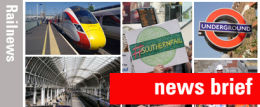Posted 22nd June 2020 | 2 Comments
Government confirms digital go-ahead for East Coast Main Line

FUNDING worth £350 million for the replacement of conventional lineside signalling with digital train regulation on the southern section of the East Coast Main Line has been announced by transport secretary Grant Shapps. The Department for Transport said it is ‘new investment’, but £12 million will come from Network Rail CP6 renewals funding.
The installation of ETCS Level 2, the signalling element of ERTMS, will be carried out on the East Coast line from London King’s Cross to Stoke Tunnel, about 9km south of Grantham, which is where the four-track main line becomes two.
The scheme is running some six years behind its original schedule. Since at least 2014 the ECML has been the host to a major ETCS experiment at Hitchin, where test laboratories have been monitoring the performance of an ETCS-equipped Class 313 test unit running on the Hertford Loop between the morning and evening peak hours.
The trials based at Hitchin followed a pioneering installation on the central Wales lines west of Shrewsbury, where all trains were fitted with ETCS for operation in normal service on the routes to Aberystwyth and Pwllheli.
ETCS uses in-cab signalling, in which equipment on board trains uses the track to communicate with the control centre.
This means that lineside signals informing the driver are no longer needed. Instead, a screen in the cab acts as a speedometer and warning panel in one. From this the driver knows how fast the train is moving, how fast it is allowed to move, and if it is moving too fast. If the permitted speed limit is exceeded for more than a few seconds (shown as a prominent warning on the screen) the train is automatically slowed down and if necessary brought to a stand.
Grant Shapps said: ‘This is just the beginning. In time, we will digitise signalling right across the country to make good on our promise of better reliability and punctuality.’
Reader Comments:
Views expressed in submitted comments are that of the author, and not necessarily shared by Railnews.

david c smith, Bletchley
My own view has been that the ECML ought to have been nominated as the basis for HS2, with its preponderance of longer intercity distances, with the WCML having the resignalling , allowing the Pendolino's to utilise their 140 mph top speed. ( The main centres , except Glasgow, on the WCML are all within 200 miles or 21/2 hours of the capital already).
Others have pointed out the possible effect of Covid 19 on demand for transport. If the need for more capacity south of Rugby still arises, then extra conventional passenger or freight capacity might come from a modified / relaid Great Central.
Gareth Marston, Newtown (Powys)
Actually paying attention to line capacity and not running "franchise arms races" over promising services that cannot be accommodated reliably would be a start. The reduced demand following lock down shows the way whereby we can run fewer , more reliable services over the busiest sections - no need to worry about franchise agreements.
Instead were throwing £ @ magic tech solutions hoping to squeeze a quart out a pint pot. The ECML capacity and reliability will still be set by terminal platform capacity at Kings X, Welwyn viaduct, flat crossing @ Newark etc. Can this simple but off message reality please be learnt in Marhsam St? I live on the Cambrian and ETCS has not allowed a single extra train to run- its all determined by (the lack of ) passing loops.